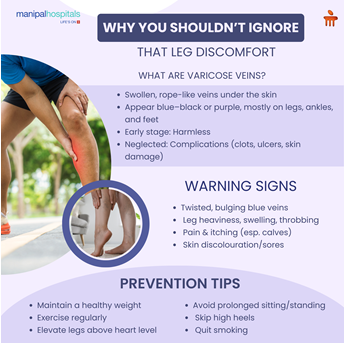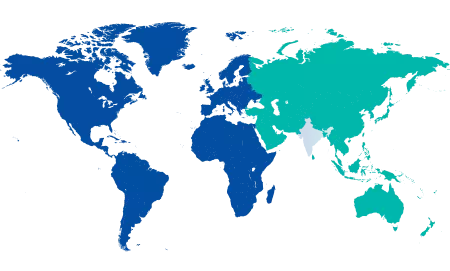
Varicose veins are swollen, rope-like blood vessels that appear as blue-black bulges just under the skin. These generally develop in the lower part of the body—particularly on the legs, ankles, and feet. Initially varicose veins seem harmless , and early diagnosis and preventive measures can prevent rapid progression. However, in NEGLECTED cases, they can lead to Complications like blood clots, skin discoloration and ulceration and then will require more complicated / prolonged treatment.
Synopsis
What causes varicose veins?

This condition is caused when walls of the veins weaken under excessive pressure of the blood column at the ankle due to gravity. Having these recurrent peaks in venous wall pressure puts strain and tension on vein walls leading to swelling of veins. In addition, repeated stretches of the vein-walls cause valves to fail. When valves fail impure blood does not flow smoothly and leaks down which leads to the manifestation of bulged, swollen and twisted veins, called varicose veins.Spider veins or reticular veins are other manifestations of increased pressure in the veins.
Vein walls tend to weaken due to various factors including weight gain, natural loss of elasticity due to ageing, tobacco use, family history and hormonal changes during pregnancy, menopause or birth control pills. Long hours of sitting or standing can also contribute to varicose veins, as gravity increases pressure in veins, causing them to bulge. This can occur even if systemic blood pressure remains normal.
Signs and symptoms
The most common symptoms of varicose veins include:
-
Distended veins: Veins may appear in clusters, looking twisted, swollen and blue-black or purple in colour, with tiny blue or red veins—known as spider veins—appearing near them.
-
Lower limb heaviness and inflammation: Leg muscles often feel fatigued, particularly after physical activity. Swelling and throbbing can also be felt in the legs, ankles and feet.
-
Pain and itching: Legs are usually painful and sore, especially in the calf. Itchiness around the varicose vein area is also a common symptom.
-
Skin sores and discolouration: Skin discolouration and sores often develop in severe cases when no treatment is provided.
Diagnosis and Treatment
To diagnose varicose veins, a doctor first conducts a physical examination to assess the symptoms mentioned above. This is followed by ultrasound imaging tests( known as venous doppler) to view internal tissues, detect blood clots and evaluate valve functioning and blood flow in the veins. These tests are usually painless.
Duplex and Doppler ultrasound are non-invasive tests that assess blood flow, valve function, blockages, and the presence of a clot; whereas venogram are intrusive (but still safe) tests utilizing X-ray imaging to look into the deeper veins.
Schedule an appointment with a reputable vascular surgeon in Millers Road to have a better understanding of your situation.
A variety of treatment methods—classified as non-invasive, minimally invasive and invasive—can effectively reduce visible symptoms and ease physical discomfort. The choice of treatment largely depends on the stage and severity of the condition.
Non-invasive:
Supportive stocking: Compressive stockings greatly help improve circulation by compressing veins and preventing backflow of blood. They also allow skin sores to heal, while preventing the formation of new sores.
Minimally invasive:
-
Injection therapy (sclerotherapy): Special chemical agents called sclerosants are injected directly into varicose veins, spider veins and other vascular lesions. These agents irritate the vein walls, causing them to inflame and close. Eventually, the veins lighten or become less apparent, and in some cases, may completely disappear.
-
Laser therapy: This type of treatment involves using a catheter to insert a tiny fibre into the varicose vein, which sends out laser energy that destroys the affected portion of the vein, causing it to eventually close and be reabsorbed by the body.
-
Radiofrequency treatment: This treatment uses radiofrequency energy to scars veins from within and close them off, particularly the large ones in the leg.
-
Ambulatory phlebectomy: In this method, the skin near the varicose veins is subjected to multiple small incisions or punctures, after which these veins are tied off and removed one section at a time.
-
GLUE: This procedure involves sealing the varicose veins with cyanoacrylate glue.
Invasive:
-
Vein surgery: This involves a method known as ‘litigation and stripping,’ where all affected varicose veins associated with the main superficial vein of the lower limb is tied off (litigated) to prevent blood from accumulating. This vein is then removed (stripped) to avoid varicose veins from reappearing.
Preventing Varicose Veins
Although varicose veins can have a genetic component, making tweaks in your everyday lifestyle can help prevent this condition. Firstly, it is very important to maintain a healthy weight as obesity is a major contributing factor. Eating a balanced diet, which is high in fibre and low in salt, along with regular exercise, reduces risk and supports overall wellbeing. Wearing high heels consistently should be avoided as they limit muscle movement and the pumping action of calf eventually leading to venous insufficiency, a root cause of varicose veins. Sitting or standing for long periods can also increase venous pressure and lead to this condition, so it is advisable to do calf muscle exercises during a period of prolonged sitting or standing
The best way to avoid this situation is to alter your position frequently or make sure your legs are held above heart level when you sit or stand. This aids to better blood circulation, and reduces swelling, heaviness and discomfort. Additionally, smoking should also be avoided, as it significantly damages blood vessels and impairs blood flow.
Conclusion
In the early stages varicose veins are typically not dangerous and can often be managed with self-care measures, neglect leads to complications that can require prolonged and complicated interventions. Depending on the stage of the condition, a personalized treatment plan is curated for each patient to ensure better long-term outcomes. Individuals are also advised to make specific lifestyle changes to help prevent or effectively manage the condition.
Manipal Hospital Millers Road has cutting-edge screening facilities that will evaluate your symptoms and provide a definitive diagnosis. Get in touch with an expert vascular surgeon today to ensure early intervention and prevent long-term complications.
FAQ's
At times varicose veins can be painful. Many people describe their pain as a throbbing sensation or a heaviness in the legs. The pain is usually gets worse with long periods of sitting or standing.
While varicose veins cannot be entirely treated at home, they can be managed to some extent through different lifestyle remedies such as diet or exercise, weight management, and compressive stockings.
In managing varicose vein symptoms, people with varicose veins should avoid overtly strenuous exercise, habits such as smoking, and wearing high heels or hanging down legs for a prolonged period of time.
Surgery can be an option when the common treatments are not relieving the pain and symptoms like swelling, pain, and skin discolouration increase. Surgery can also be completed for cosmetic reasons to make the area look better.
Varicose veins that are treated will typically not grow back in the same area. However, new varicose veins can sometimes occur in different areas.





















 7 Min Read
7 Min Read


10.png)




8.png)





